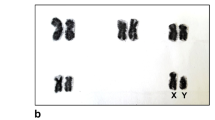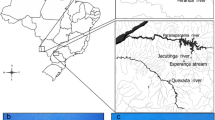Abstract
The chromosomal complements of nine species of Blenniidae (Aidablennius sphynx, Blennius ocellaris, Lypophris adriaticus, L. pavo, L. trigloides, Parablennius gattorugine, P. ponticus, P. sanguinolentus, P. tentacularis) from the Adriatic Sea were analysed with several banding methods and in-situ hybridization. In all species, the diploid set consists of 48 mostly acrocentric chromosomes and has a similar location (terminal centromeric) of NORs, except for L. pavo (interstitial pericentric) and P. ponticus (terminal on the long arm). There are major differences in karyotype with regard to the amount and distribution of heterochromatin. Parablennius tentacularis shows a distinctive sex-chromosome system involving 2n=48 males with a large totally heterochromatic Y chromosome, and males with 2n=47. This difference is likely to be the consequence of a translocation of an autosome on the original Y. This finding constitutes an additional instance of the great variability in origins of multiple sex chromosome systems in vertebrates.
Similar content being viewed by others
References
Almeida Toledo LF, Viegas-Pequignot E, Foresti F, Almeida Toledo-Filho SA, Dutrillaux B (1988) BdrU replication pattern demonstrating chromosome homeologies in two fish species, genus Eigenmannia. Cytogenet Cell Genet 48: 117–120.
Almeida Toledo LF, Foresti F, Zambelli Daniel MF, Almeida Toledo-Filho SA (1993) Nucleolar chromosome variants in Sternopygus macrurus (Pisces, Sternoopygidae) from three Brazilian river basins. Caryologia 46: 53–61.
Amemyia C, Gold JR (1988) Chromosomal NOR as taxonomic and systematic characters in North American cyprinid fishes. Genetica 76: 81–90.
Bacescu M (1985) The effect of the geological and physico-chemical factors on the distribution of marine plants and animals in the Mediterranean. In: Moraitou-Apostolopoulou M, Kiortsis V, eds. Mediterranean Marine Ecosystems. New York: Plenum Press, pp 195–212.
Bertollo LAC, Cavallaro ZI (1992) A highly differentiated ZZ/ZW sex chromosome system in a Characidae fish, Triportheus guentheri. Cytogenet Cell Genet 60: 60–63.
Cano J, Alvarez MC, Thode G, Muñoz E (1982) Phylogenetic interpretation of chromosomal and nuclear DNA content data in the genus Blennius (Blenniidae: Perciformes). Genetica 58: 11–16.
Caputo V (1998) Nucleolar organizer (NOR) location and cytotaxonomic implications in six species of gobiid fishes (Perciformes, Gobiidae). Ital J Zool 65: 93–99.
Caputo V, Marchegiani F, Olmo E (1996) Karyotype differen-tiation between two species of carangid fishes, genus Trachurus (Perciformes: Carangidae). Mar Biol 127: 193–199.
Caputo V, Marchegiani F, Sorice M, Olmo E (1997) Heterochromatin heterogeneity and chromosome variability in four species of gobiid fishes (Perciformes: Gobiidae). Cytogenet Cell Genet 79: 266–271.
Carbone P, Vitturi R, Catalano E, Macaluso M (1987) Chromosome sex determination and Y-autosome fusion in Blennius tentacularis Brunnich, 1765 (Pisces, Blennidae). J Fish Biol 31: 597–602.
Catalano E, Vitturi V, Zava B, Macaluso M (1985) Ritrovamento di Parablennius pilicornis (Cuvier, 1829) nelle acqua italiane e suo cariotipo (Pisces Blennidae). Natura 126: 155–164.
Clark MS, Wall WJ (1996) Chromosomes. The Complex Code. London: Chapman & Hall.
Ferreira Artoni R, Molinar WF, Bertollo LAC, Galetti PM (1999) Heterochromatin analysis in the fish species Liposarcus anisitsi (Siluriformes) and Leporinus elongates (Characiformes). Genet Mol Biol 22: 39–44.
Galetti PM, Foresti F (1986) Evolution of ZZ/ZW system in Leporinus (Pisces, Anostomidae). Cytogenet Cell Genet 43: 43–46.
Galetti PM, Mestriner CA, Venere PC, Foresti F (1991) Heterochromatin and karyotype reorganization in fish of the family Anostomidae (Characiformes). Cytogenet Cell Genet 56: 116–121.
Garcia E, Alvarez MC, Thode G (1987) Chromosome relationships in the genus Blennius (Blenniidae Perciformes) C-banding suggest two karyoevolutional pathways. Genetica 72: 27–36.
Hastie ND, Allshire RC (1989) Human telomeres: fusion and interstitial sites. Trends Genet 5: 326–331.
Hatch FT, Bodner AJ, Mazrimas JA, Moore DH (1976) Sat-ellite DNA and cytogenetic evolution. DNA quantity, satel-lite DNA and karyotypic variation in kangaroo rats (genus Dipodomys). Chromosoma 58: 155–168.
Howell WM, Black DA (1980) Controlled silver-staining of nucleolar organizer regions with protective colloidal developer: a 1–step method. Experientia 36: 1014.
King M (1980) C-banding studies on Australian hylid frogs: secondary constriction structure and the concept of euchromatin transformation. Chromosoma 80: 191–217.
King M (1993). Species Evolution: The Role of Chromosome Change. Cambridge: Cambridge University Press.
Klinkhardt M, Tesche M, Greven H (1995). Data Base of Fish Chromosomes. Magdeburg: Westarp Wissenschaften.
Levan A, Fredga K, Sandberg AA (1964). Nomenclature for centromeric position on chromosomes. Hereditas 52: 201–220.
Lozano R, Ruiz Rejon C, Ruiz Rejon M (1992) A comparative analysis of NORs in diploid and triploid salmonids: implications with respect to the diploidization process occurring in this fish group. Heredity 68: 450–457.
Miura I (1995) The late replication banding patterns of chromosomes are highly conserved in the genera Rana, Hyla and Bufo (Amphibia: Anura). Chromosoma 103: 567–574.
Morescalchi A (1992) Chromosomes, sex determination and environment in teleosteans. In: Dallai R, ed. Selected Symposia and Monographs UZI 6. Modena: Mucchi, pp 137–149.
Morescalchi A, Hureau JH, Olmo E, Ozouf-Costaz C, Pisano E, Stanyon R (1992) A multiple sex-chromosome system in Antarctic ice-fishes. Polar Biol 11: 655–661.
Nelson J (1994) Fishes of the World. New York: John Wiley & Sons.
Odierna G, Kupriyanova LA, Capriglione T, Olmo E (1993) Further data on sex chromosomes of Lacertidae and a hypothesis on their evolutionary trend. Amphibia Reptilia 14: 1–11.
Phillips RB, Pleyte KA, Hartley SE (1988) Stock-speci¢c dif-ferences in the number and chromosome position of the nucleolar organizer regions in Arctic char (Salvelinus alpinus). Cytogenet Cell Genet 48: 9–12.
Salvadori S, Deiana A, Coluccia E, Floridia G, Rossi E, Zuffardi O (1995) Colocalization of (TTAGGG)n telomeric sequences and ribosomal genes in Atlantic eels. Chromosome Res 3: 54–58.
Schmid M, Haaf T, Geile B, Sims S (1983) Chromosome banding in amphibia VII. An unusual XY/XX sex chromosome system in Gastrotheca riobambae (Anura, Hylidae), Chromosoma 88: 69–82.
Schweizer D (1976) Reverse £uorescent chromosome banding with chromomycin and DAPI. Chromosoma 58: 307–324.
Singh L, Purdom IF, Jones KW (1976) Satellite DNA and the evolution of sex chromosomes. Chromosoma 59: 43–62.
Sola L, Rossi AR, Iaselli V, Rasch EM, Monaco PJ (1992) Cytogenetics of bisexual/unisexual species of Poecilia. II. Analysis of heterochromatin and nucleolar organizer regions in Poecilia mexicana mexicana by C-banding and DAPI, quinacrine, chromomycin A3 and silver staining. Cytogenet Cell Genet 60: 229–235.
Sumner AT (1972) A simple technique for demonstrating centromeric heterocromatin. Exp Cell Res 75: 304–306.
Takai A, Ojima Y (1986) Some features on nucleolus organizer regions in fish chromosomes. In: Uyeno T, Arai R, Taniuchi T, Matsuura K, eds. Indo-Paci¢c Fish Biology. Tokyo: Ichthyological Society of Japan, pp 899–909.
Tortonese E (1975) Fauna d'Italia, Vol. XI. Osteichthyes, Pesci ossei. Bologna: Calderini.
Tortonese E (1985) Distribution and ecology of endemic elements in the Mediterranean fauna (fishes and echinoderms). In: Moraitou-Apostolopoulou M, Kiortsis V, eds. Mediterranean Marine Ecosystems. New York: Plenum Press, pp. 18–30.
Vitturi R, Carbone P, Catalano E, Macaluso M (1986) Karotypes of ¢ve species of Blennioidea (Pisces, Perciformes). Caryologia 39: 273–279.
Vitturi R, Catalano E, Lafargue F (1991) Evidence for heteromorphic sex chromosomes in Zeus faber (Pisces, Zeiformes): nucleolus organizer regions and C-banding pattern. Cytobios 68: 37–43.
Vitturi R, Colomba MS, Caputo V, Sparacio I, Barbieri R (1997) High heterochromatic content in somatic chromo-somes of two unrelated species of Diplopoda (Myriapoda). Chromosome Res 5: 407–412.
Zander CD (1974) Evolution of Blennioidei in the Mediterranean Sea. Int Explor Scient Mer Me¨diterr 22: 57.
Zander CD (1986) Check-list of the Fishes of the North-Eastern Atlantic and of theMediterranean. Vol. III. Blenniidae. Paris: Unesco. pp 1096–1112.
Zurita F, Jimenez R, Diaz de la Guardia R, Burgos M (1999) The relative rDNA content of a NOR determines its level of expression and its probability of becoming active. A sequential silver staining and in-situ hybridization study. Chromosome Res 7: 563–570.
Author information
Authors and Affiliations
Rights and permissions
About this article
Cite this article
Caputo, V., Machella, N., Nisi-Cerioni, P. et al. Cytogenetics of nine species of Mediterranean blennies and additional evidence for an unusual multiple sex-chromosome system in Parablennius tentacularis (Perciformes, Blenniidae). Chromosome Res 9, 3–12 (2001). https://doi.org/10.1023/A:1026779314932
Issue Date:
DOI: https://doi.org/10.1023/A:1026779314932




